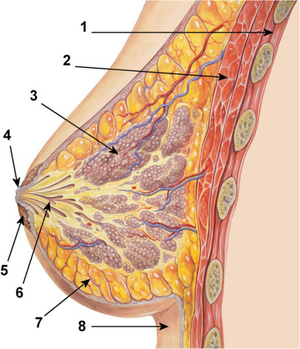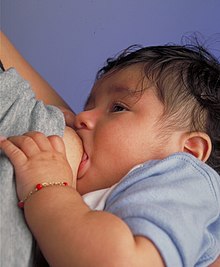Blocked milk duct
| Blocked milk duct | |
|---|---|
| Other names: Clogged milk duct, plugged milk duct | |
 | |
| Milk ducts (arrow 6) | |
| Specialty | Family medicine |
| Symptoms | Small tender lump, affected one breast[1][2] |
| Complications | Mastitis[3] |
| Causes | Breast engorgement, insufficiently breastfeeding, injury of the breast[4] |
| Differential diagnosis | Breast engorgement, breast abscess, Pagetʼs disease of the breast[5] |
| Treatment | Frequent feeding, applying warmth and cold[2][5] |
| Frequency | Common during breastfeeding[4] |
A blocked milk duct is when one or more ducts carrying milk to the nipple is not draining.[2] Symptoms include a small tender lump, with potentially redness of the overlying skin.[1][2] Generally only one breast is affected and fever is not present.[1][5] A milk bleb may also occur at the nipple.[6] Complications may include mastitis.[3]
It may occur as a result of breast engorgement, insufficiently frequency of breastfeeding, poor attachment by the baby, or pressure on the breast such as from a seatbelt or poorly fitted bra.[2][4] The underlying mechanism may involve thick milk blocking a milk duct, resulting in a build up of pressure.[1][4] It may be associated with a milk bleb at the nipple.[5]
Treatment is generally by frequent feeding and application of alternating warmth and cold.[2][5] While massage of the lump towards the nipple when feeding has been recommended,[2][5] this practice may cause injury and has been discouraged by others.[7] Once the thick milk is removed, and the duct drains, symptoms generally rapidly resolve.[1] A blocked milk duct is common during breastfeeding.[4]
Signs and symptoms
A blocked milk duct has the following common symptoms:[8][9]
- Low fever and breast infection
- Pain in a particular side of the breast
- Swollen or tender lump in the breast
- Slower milk flow
- a small white blister on the nipple called a milk bleb
- swelling or redness of the breast
- areas of the breast that are hot or warm to touch
- the infant may feel fussy when feeding from the affected breast
Causes
Blocked milk ducts are a common breastfeeding problem and can be caused due to a number of reasons:[8][10]
- When the infant does not latch properly
- Wearing a tight bra or tight clothing can restrict the breasts and put pressure on them leading to a blocked milk duct
- A bad or weak pump could lead to a drainage issue
- When the breast milk is not removed regularly, the milk can back up and create a blockage
- A nipple bleb can also block the milk duct
- When the body produces milk in over abundance, it can engorge the breast and hence lead to a blockage
- Other reasons include fatigue, over exercise, dehydration and weaning.
Treatment

The most effective treatment against blocked milk ducts is to empty the affected breasts by frequent breastfeeding or pumping.[11] Numerous other treatment approaches have been suggested, however, there is insufficient clinical research to determine the effectiveness.
Efforts that have been studied but with unclear evidence include:
- A gentle massage of the affected breast[12] Sometimes after gentle massage over the lump, a string of the thickened milk comes out through the nipple, followed by a stream of milk, and rapid relief of the blocked duct.[1]
- Ensuring a correct positioning and latching of the baby[12]
- Wearing loose clothing items that do not bind the breasts[13]
- Applying warm compresses[12]
- Drinking a specialized herbal tea[13]
- Acupuncture[12]
- Gua-Sha[12]
- Proteolytic enzymes[12]
A blocked milk duct can result from a nipple bleb. Both of these can lead to mastitis.[14]
References
- ↑ 1.0 1.1 1.2 1.3 1.4 1.5 "Management of breast conditions and other breastfeeding difficulties". National Center for Biotechnology Information US National Library of Medicine. Archived from the original on 18 January 2017. Retrieved 4 August 2017.
 This article incorporates text from this source, which is in the public domain.
This article incorporates text from this source, which is in the public domain.
- ↑ 2.0 2.1 2.2 2.3 2.4 2.5 2.6 "Breast pain and breastfeeding". nhs.uk. 7 December 2020. Archived from the original on 17 January 2024. Retrieved 25 January 2024.
- ↑ 3.0 3.1 "Lactation and nipple problems | DermNet". dermnetnz.org. Archived from the original on 2 October 2023. Retrieved 25 January 2024.
- ↑ 4.0 4.1 4.2 4.3 4.4 "Plugged Ducts, Mastitis, and Thrush | WIC Breastfeeding Support". wicbreastfeeding.fns.usda.gov. Archived from the original on 2 January 2024. Retrieved 25 January 2024.
- ↑ 5.0 5.1 5.2 5.3 5.4 5.5 Jacobs, A; Abou-Dakn, M; Becker, K; Both, D; Gatermann, S; Gresens, R; Groß, M; Jochum, F; Kühnert, M; Rouw, E; Scheele, M; Strauss, A; Strempel, AK; Vetter, K; Wöckel, A (December 2013). "S3-Guidelines for the Treatment of Inflammatory Breast Disease during the Lactation Period: AWMF Guidelines, Registry No. 015/071 (short version) AWMF Leitlinien-Register Nr. 015/071 (Kurzfassung)". Geburtshilfe und Frauenheilkunde. 73 (12): 1202–1208. doi:10.1055/s-0033-1360115. PMID 24771901.
- ↑ "Plugged Milk Ducts and Nipple Blebs" (PDF). Archived (PDF) from the original on 13 June 2023. Retrieved 27 January 2024.
- ↑ Kaptanian, Melissa (9 November 2022). Management of Benign Breast Disease, An Issue of Surgical Clinics, E-Book: Management of Benign Breast Disease, An Issue of Surgical Clinics, E-Book. Elsevier Health Sciences. p. 977. ISBN 978-0-323-98734-9. Archived from the original on 28 January 2024. Retrieved 27 January 2024.
- ↑ 8.0 8.1 "Clogged Milk Ducts: Symptoms, Causes and Treatments". www.thebump.com. Archived from the original on 2019-09-21. Retrieved 2019-09-21.
- ↑ "Reasons for blocked ducts". Medela. Archived from the original on 2019-09-21. Retrieved 2019-09-21.
- ↑ "Clogged milk duct: Symptoms, home remedies, and prevention". Medical News Today. 3 September 2018. Archived from the original on 2019-09-21. Retrieved 2019-09-21.
- ↑ Roberts, Kathryn L.; Reiter, Maureen; Schuster, Diane (September 1998). "Effects of Cabbage Leaf Extract on Breast Engorgement". Journal of Human Lactation. 14 (3): 231–236. doi:10.1177/089033449801400312. ISSN 0890-3344. PMID 10205435. S2CID 13110956.
- ↑ 12.0 12.1 12.2 12.3 12.4 12.5 Zakarija-Grkovic, Irena; Stewart, Fiona (18 September 2020). "Treatments for breast engorgement during lactation". The Cochrane Database of Systematic Reviews. 2020 (9): CD006946. doi:10.1002/14651858.CD006946.pub4. ISSN 1469-493X. PMC 8094412. PMID 32944940.
- ↑ 13.0 13.1 "Tackling engorgement and mastitis: an all-in-one guide". www.meandqi.com. Archived from the original on 2019-03-26. Retrieved 2019-03-26.
- ↑ Walker, Marsha (2011). Breastfeeding management for the clinician : using the evidence. Sudbury, Mass: Jones and Bartlett Publishers. p. s 534–5. ISBN 9780763766511.